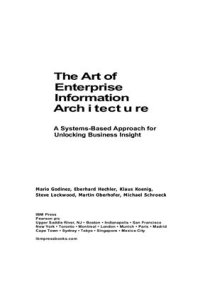
Ebook: etc. The Art of Enterprise Information Architecture. A Systems-Based Approach for Unlocking Business Insight
Author: Godinez M.
- Genre: Computers // Information Systems
- Tags: Информатика и вычислительная техника, Проектирование информационных систем
- Language: English
- pdf
Издательство IBM Press, 2010, -462 pp.In the past two years, I have become more involved in what my company, Capgemini, has fondly started to describe as the "business technology agora," a place where IT and business people meet, discuss, make decisions, and prepare for action. Like in the old Greek cities, this agora proves to be a catalyst for dialogue, a gathering place for different stakeholders to reach out to the others and improve understanding.
By using the principles of the Business Technology Agora, we carefully identify the most important business drivers of an organization, map these to technology solutions in different categories, and discuss impact, timing, and implementation issues. Categorizing solutions in different areas helps to simplify the technology landscape, but it also provides us with a wealth of insight into what areas of IT truly matter to the business of our clients.
If there is one dominant category that we have identified in these two years of business technology sessions across the world, it is no doubt "Thriving on Data." The abundant, ubiquitous availability of real-time information proves to be the single most important requirement to satisfying the needs of the business.
Organizations envision thriving on data in many different ways. One way might be to simply get more of a grip on corporate performance by creating a more integrated view of client-related information and having management dashboards that truly show the actual state of the business. Another way, being used more often, is to carefully analyze data from inside and outside of the enterprise to predict and understand what might happen next. Above all, the exchange of meaningful data is the glue that binds all the actors (man, machine, anything else) in the highly interconnected, network of everything that nowadays defines our business environment; data literally gets externalized and becomes the main tool for organizations to reach out to the outside world.
Given the extreme importance of data today, it is surprising that many organizations do not seem to be able to govern their data properly, let alone use data in a strategic way to achieve their objectives. Data is often scattered across the enterprise. There are no measures to guarantee consistency, and ownership is unclear. The situation becomes even more difficult when different business entities are involved or when data needs to be shared between organizations. This is a truly complex problem and businesses need a much more architectural approach for leveraging their data.
In my other role as a board member of The Open Group, I have come to value the role of architecture as a tool not only to bring structure and simplification to complex situations, but also to bridge the views of the different stakeholders involved. If we are to achieve boundary-less information flow inside and between organizations, which is the ultimate goal of The Open Group, we need standards. Standards aren't only about the terms of definitions and semantics but about the methodologies we apply and the models that we build on. After all, ever since the rise and fall of the Tower of Babel, we know that successful collaboration depends on the ability to share the same ways of working, to share the same objectives, to build on a common foundation, and to be culturally aligned. Essentially, it is about speaking the same language in the broadest sense of the word.
The authors of this book aim for nothing less than creating an architectural perspective on enterprise information, and they have embarked on a mission of epical proportions. By bringing together insights and best practices from all over the industry, they provide us with the models, methodologies, diagnostics, and tools to get a grip on enterprise information. They show us how enterprise information fits into the broader context of enterprise architecture frameworks, such as The Open Group Architecture Framework (TOGAF). They introduce a multi-layered information architecture reference model that has the allure of a standard, common foundation for the entire profession. They also show us how Enterprise Information Architecture (EIA) alludes to emerging, contemporary topics such as SOA, business intelligence, cloud-based delivery, and master data management.
However, most of all, they supply us with a shared, architectural language to create oversight and control in the Babylonic confusion that we call the enterprise information landscape. When the business and IT side of the enterprise share the same insights around the strategic value of information and when they mutually agree on the unprecedented importance of information stewardship, they start to see the point of this book—how to unleash the power of enterprise information and how to truly thrive on data.The Imperative for a New Approach to Information Architecture
Introducing Enterprise Information Architecture
Data Domains, Information Governance, and Information Security
Enterprise Information Architecture: A Conceptual and Logical View
Enterprise Information Architecture: Component Model
Enterprise Information Architecture: Operational Model
New Delivery Models: Cloud Computing
Enterprise Information Integration
Intelligent Utility Networks
Enterprise Metadata Management
Master Data Management
Information Delivery in a Web 2.0 World
Dynamic Warehousing
New Trends in Business Analytics and Optimization
A: Software Product Mapping
B: Standards and Specifications
C: Regulations
By using the principles of the Business Technology Agora, we carefully identify the most important business drivers of an organization, map these to technology solutions in different categories, and discuss impact, timing, and implementation issues. Categorizing solutions in different areas helps to simplify the technology landscape, but it also provides us with a wealth of insight into what areas of IT truly matter to the business of our clients.
If there is one dominant category that we have identified in these two years of business technology sessions across the world, it is no doubt "Thriving on Data." The abundant, ubiquitous availability of real-time information proves to be the single most important requirement to satisfying the needs of the business.
Organizations envision thriving on data in many different ways. One way might be to simply get more of a grip on corporate performance by creating a more integrated view of client-related information and having management dashboards that truly show the actual state of the business. Another way, being used more often, is to carefully analyze data from inside and outside of the enterprise to predict and understand what might happen next. Above all, the exchange of meaningful data is the glue that binds all the actors (man, machine, anything else) in the highly interconnected, network of everything that nowadays defines our business environment; data literally gets externalized and becomes the main tool for organizations to reach out to the outside world.
Given the extreme importance of data today, it is surprising that many organizations do not seem to be able to govern their data properly, let alone use data in a strategic way to achieve their objectives. Data is often scattered across the enterprise. There are no measures to guarantee consistency, and ownership is unclear. The situation becomes even more difficult when different business entities are involved or when data needs to be shared between organizations. This is a truly complex problem and businesses need a much more architectural approach for leveraging their data.
In my other role as a board member of The Open Group, I have come to value the role of architecture as a tool not only to bring structure and simplification to complex situations, but also to bridge the views of the different stakeholders involved. If we are to achieve boundary-less information flow inside and between organizations, which is the ultimate goal of The Open Group, we need standards. Standards aren't only about the terms of definitions and semantics but about the methodologies we apply and the models that we build on. After all, ever since the rise and fall of the Tower of Babel, we know that successful collaboration depends on the ability to share the same ways of working, to share the same objectives, to build on a common foundation, and to be culturally aligned. Essentially, it is about speaking the same language in the broadest sense of the word.
The authors of this book aim for nothing less than creating an architectural perspective on enterprise information, and they have embarked on a mission of epical proportions. By bringing together insights and best practices from all over the industry, they provide us with the models, methodologies, diagnostics, and tools to get a grip on enterprise information. They show us how enterprise information fits into the broader context of enterprise architecture frameworks, such as The Open Group Architecture Framework (TOGAF). They introduce a multi-layered information architecture reference model that has the allure of a standard, common foundation for the entire profession. They also show us how Enterprise Information Architecture (EIA) alludes to emerging, contemporary topics such as SOA, business intelligence, cloud-based delivery, and master data management.
However, most of all, they supply us with a shared, architectural language to create oversight and control in the Babylonic confusion that we call the enterprise information landscape. When the business and IT side of the enterprise share the same insights around the strategic value of information and when they mutually agree on the unprecedented importance of information stewardship, they start to see the point of this book—how to unleash the power of enterprise information and how to truly thrive on data.The Imperative for a New Approach to Information Architecture
Introducing Enterprise Information Architecture
Data Domains, Information Governance, and Information Security
Enterprise Information Architecture: A Conceptual and Logical View
Enterprise Information Architecture: Component Model
Enterprise Information Architecture: Operational Model
New Delivery Models: Cloud Computing
Enterprise Information Integration
Intelligent Utility Networks
Enterprise Metadata Management
Master Data Management
Information Delivery in a Web 2.0 World
Dynamic Warehousing
New Trends in Business Analytics and Optimization
A: Software Product Mapping
B: Standards and Specifications
C: Regulations
Download the book etc. The Art of Enterprise Information Architecture. A Systems-Based Approach for Unlocking Business Insight for free or read online
Continue reading on any device:

Last viewed books
Related books
{related-news}
Comments (0)











